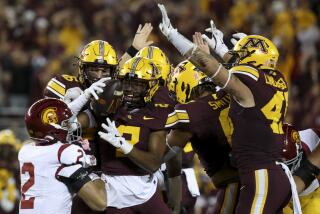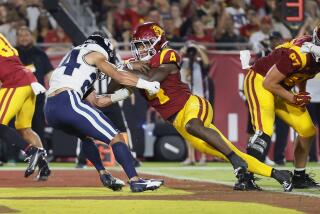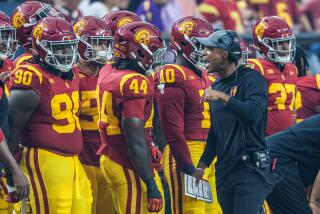Dark Clouds Trail Titans, Obscuring Sunny Start
Now that the sun has deemed UC Irvine worthy again of its glow, the Big West storm front has moved north to Cal State Fullerton, to the land of Cedric Ceballos, lofty preseason predictions, early NCAA aspirations . . . and, presently, a 12-13 won-lost record.
The Titans, owners of a 5-0 record on Dec. 16, now own an 0-5 record since Feb. 3.
The Titans, handicapped as high as second in the November Big West forecasts, now are handicapped with a 6-10 conference record and consigned to seventh place.
The Titans, with four starters back from last season’s 16-13 team, now need an improbable sweep of Irvine and Nevada-Las Vegas in their last two games to avoid taking a losing record into the conference’s all-comers tournament.
Amid the stench of disappointment at Fullerton, Coach John Sneed points to his public preseason warning, by which he claimed it would be “unrealistic” to expect the Titans to repeat their luck-laden performance of 1988-89. That Fullerton team was the surprise of the Big West, a collection of unknowns and never-weres that ambushed out of the bushes and forced six overtime games, winning five of them.
Those Titans had Fate playing sixth man, so maybe Sneed had a point. Maybe last season was the best-case scenario played out to its fullest and any 1989-90 encore was doomed before the first tipoff.
Still, this team sports all the classic signs of underachievement and the frustration that results from dashed high hopes.
Keith Starr, a first-year assistant coach, resigns.
John Sykes, last year’s starting center, is kicked off the team.
Derek Jones, the departed ’89 power forward who averaged 11.5 points and 6.9 rebounds, becomes canonized as The Missing Link, the oh-so-suddenly irreplaceable part.
And Sneed, according to courtside accounts, has become increasingly testy, venting his spleen with everyone from the Titan Gym timekeeper to the public address announcer to the team’s radio broadcaster.
It is not a happy time to be a Titan. With the exception of Ceballos, the all-conference forward headed for bigger things in the NBA, no one in orange-and-blue has performed to expectations, unrealistic or otherwise.
Mark Hill, the No. 2 scorer in the Big West as junior, has seen his average slip from 19.3 points a game to 18.8 and his shooting percentage drop from .448 to .404. In two losses to UC Santa Barbara, Hill went a combined 2-for-26 from the field. Monday night against Cal State Long Beach, Hill had 18 points in the first half, scored the first basket of the second half . . . and didn’t make another field goal the rest of the way, including the five-minute overtime.
Wayne Williams, the sophomore point guard, continues to rank as the Titans’ Buzzer Beater, the nickname bestowed upon him last season by Hill. In his two-year Fullerton career, Williams has beaten six buzzers--first half or second half--with baskets. Too bad the buzzer sounds only twice a game. The rest of the time, Williams is a 34% shooter, with better success outside the three-point line (40%) than inside it (29%).
Opposite Ceballos, who’s averaging 22.4 points and 12.2 rebounds, the other forward position has been shared by Agee Ward and Van Anderson. Combined, they’re averaging less than 10 points a game. And the center, David Moody, is a fifth-year senior getting his chance in the wake of Sykes’ spin-out, averaging 4.6 points a game.
Of course, that’s twice as high as the 2.1 average left behind by Sykes, who could be counted on for his one dunk a game, if nothing else.
In a way, the whole Sykes saga summarizes the Titans’ fall this winter. Last season, for reasons yet unexplained, Sykes, a player of ordinary skills, went psycho--hence the nickname--and became a ball of terror down the stretch. He tore down rebounds, he hustled on defense, he dove for loose balls and he became an inspirational force as Fullerton won eight of its last 11 games.
This season, Sykes was only half there. First he was sidelined by a mysterious and reoccuring eye infection that ultimately turned out to be the result of poorly cleaned contact lenses. Then he contracted strep throat.
In and out of the lineup, Sykes traipsed in and out of Sneed’s doghouse before the coach finally cut him last week for missing study hall and team meetings.
The early indicators for a successful Titan run in 1990 may well have been fool’s gold. Half of last season’s 16 victories were decided by three points or less. Five were won in overtime.
With just two more bad bounces, that 16-13 record could have been 14-15, right on track with the current 12-13 pace.
And that 5-0 start? Consider the opposition:
Lamar, now the last-place team in the America South Conference at 6-19.
West Texas State, a Division II school.
St. Mary’s, a 6-18 team that was forced to play without Coach Paul Landreaux that night.
Tulsa, the fourth-place team in the Missouri Valley Conference.
And Cal State Northridge, another Division II school.
By the time Fullerton met up with taller competition--Colorado State, UCLA, Las Vegas--those credentials were rudely placed in their proper corner.
So, was Sneed right and all the evil, know-nothing, ill-intentioned experts wrong last November? Are the Titans merely playing to form, now that the cloud cover’s been lifted?
Well, here are some more questions to ponder.
Don’t good young teams generally get better?
Shouldn’t Fullerton beat undermanned opponents such as San Jose State, Fresno State and the University of the Pacific?
How do the Titans miss six free throws in the last 2:20 and blow an 11-point lead at home against Santa Barbara?
Shouldn’t Hill have hit that wide-open three-pointer at the buzzer Saturday against New Mexico State?
Shouldn’t Anderson have hit that 12-foot bank shot on the last play of overtime against Long Beach?
Shouldn’t these Titans have a winning record?
At Fullerton, you don’t need a weatherman to tell you which way the wind’s blowing.
More to Read
Go beyond the scoreboard
Get the latest on L.A.'s teams in the daily Sports Report newsletter.
You may occasionally receive promotional content from the Los Angeles Times.










